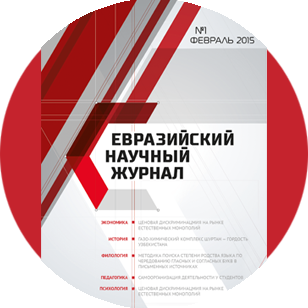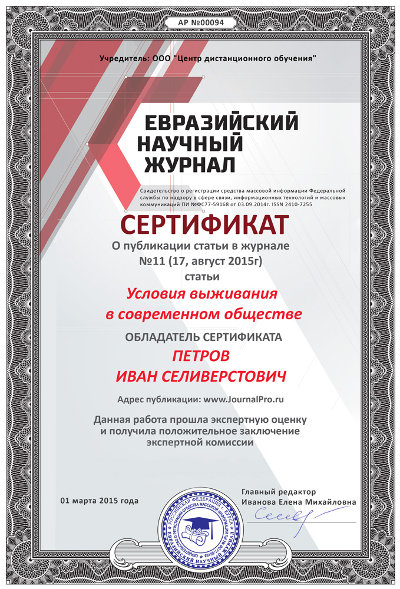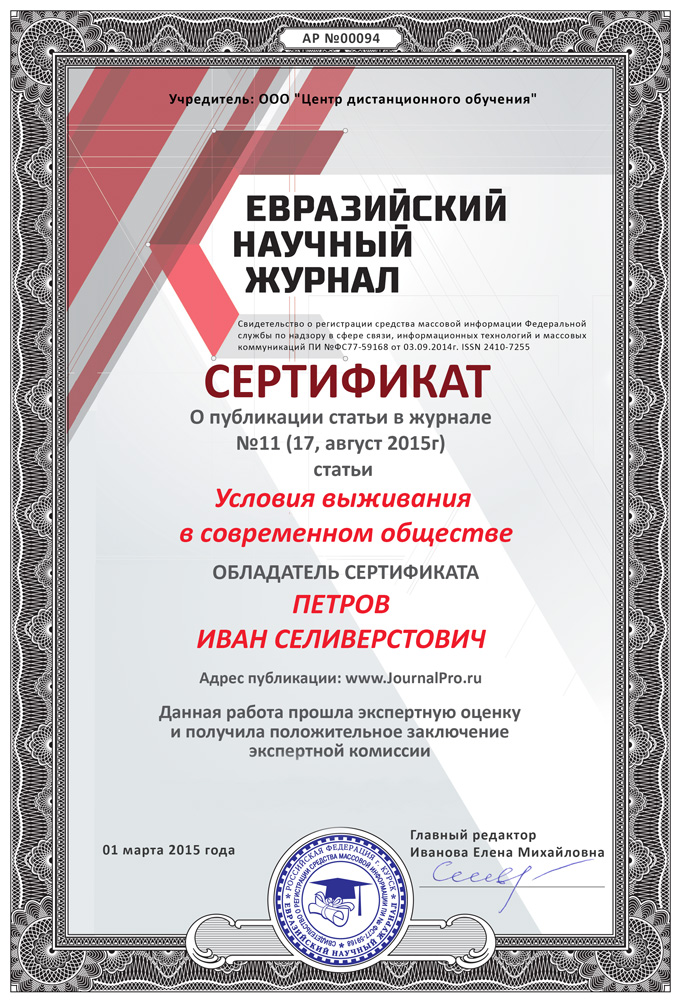Срочная публикация научной статьи
+7 995 770 98 40
+7 995 202 54 42
info@journalpro.ru
Application of the fuzzy linear programming in the proportions of problem
Рубрика: Физико-математические науки
Журнал: «Евразийский Научный Журнал №3 2016» (март)
Количество просмотров статьи: 4506
Показать PDF версию Application of the fuzzy linear programming in the proportions of problem
Modeling and optimization under a fuzzy environment are called fuzzy modeling and fuzzy optimization. Fuzzy multi-objective linear programming is one of the most frequently applied in fuzzy decision making techniques. Although, it has been investigated and expanded for more than decades by many researchers and from the varies point of view, it is still useful to develop new approaches in order to better fit the real world problems within framework of fuzzy multi-objective linear programming.
However, when formulating the multi-objective programming problem which closely describes and represents the real decision situation, various factors of the real system should be reflected in the description of the objective functions and the constraints. Naturally, these objective functions and the constraints involve many parameters whose possible values may be assigned by the experts. In the traditional approaches, such parameters are fixed at some values in an experimental or subjective manner through the expert's understanding of the nature of the parameters. Unfortunately, real world situations are often not deterministic. There exist various types of uncertainties in social, industrial and economic systems, such as randomness of occurrence of events, imprecision and ambiguity of system data and linguistic vagueness, etc. which come from many ways, including errors of measurement, deficiency in history and statistical data, insufficient theory, incomplete knowledge expression and the subjectivity and preference of human judgment, etc. As pointed out by Zimmermann (1978), various kinds of uncertainties can be categorized as stochastic uncertainty and fuzziness.
Stochastic uncertainty relates to the uncertainty of occurrences of phenomena or events. Its characteristics, lie in that descriptions of information are crisp and well defined; however, they vary in their frequency of occurrence. The systems with this type of uncertainty are called stochastic systems, which can be solved by stochastic optimization techniques using probability theory.
In some other situations, the decision-maker does not think about the frequently used probability distribution which is always appropriate, especially when the information is vague. It may be related to human
language and behavior, imprecise/ ambiguous system data. Such types of uncertainty are called fuzziness. It cannot be formulated and solved effectively by traditional mathematics-based optimization techniques and probability based stochastic optimization approaches.
Multi-objective Linear Programming (MOLP) Problem:
Multi-objective Linear Programming (MOLP) Problems is an interest area of research, since most real-life problems have a set of conflict objectives. A mathematical model of the MOLP problem can be written as follows:
where x is an n – dimensional vector of decision variables are k – distinct linear objective function of the decision vector . A is an mxn constraint matrix, b is an m – dimensional constant vector.
Definition 3. 1. (Complete Optimal Solution) The point is said to be a complete optimal solution of the MOLP problem (1), if
for all
In general, when the objective functions conflict with one another, a complete optimal solution may not exist and hence, a new concept of optimality, called Pareto optimality, is considered.
Definition 3. 2. (Pareto Optimal Solution) The point is said to be a Pareto optimal solution if there does not exist
such that if
for all i and
for at least one j
Fuzzy Multi-objective Linear Programming (FMOLP) Problem:
The model (1), all coefficients of A, b and C are crisp numbers. However, in the real-world decision
problems, a decision maker does not always know the exact values of the coefficients taking part in the problem, and that vagueness in the coefficients may not be a probabilistic
type. In this situation, the decision maker can
model inexactness by means of fuzzy parameter. In
this section we consider a FMOLP problem with fuzzy technological coefficients and fuzzy resources. A mathematical model of the FMOLP problem can be written as
follows:
where x is an n – dimensional vector of decision variables. are k - distinct linear objective
function of the decision vector dimensional cost factor vectors
is an mxn constraint fuzzy matrix
- dimensional constant fuzzy vector (fuzzy resources).
The membership
function of the fuzzy matrix:
Solution Methodology and Algorithm:
In this section, we first fuzzify the objective function in order to defuzzificate the problem (2). It is done by
calculating the lower and upper bounds of the optimal values. The bounds of the optimal values and
are obtained by solving the standard linear programming problems.
Let = min
and
the objective function takes the values between and while the technological coefficients take values between
and
and the right hand side numbers takes the value
and
then the fuzzy set of
timal value,
which sub set for
is defined by
The fuzzy set of the constraint,
which subset for
, is defined by
By using the definition of the fuzzy decision proposed by Bellman and Zadeh, we have:
In this case the optimal fuzzy decision is a solution of the problem
Consequently, the problem (2) is reduced to the following optimization problem
Notice that, the problem (11) containing the cross product terms are not convex Therefore, the solution of the problem requires the special approach adopted for solving general non-convex optimization problems.
The Algorithm of the Fuzzy Decisive Set Method:
This method is based on the idea that, for a fixed value of , the problem (11) is converted in to linear
programming problem. Obtaining the optimal solutionis equivalent to determining the maximum value of so that the feasible set is nonempty. The algorithm of this method for the problem (11) is presented below.
Algorithm:
Step 1:
Set λ =1 and test whether a feasible set satisfying the constraints of the problem (11) exists or not using
phase one of the simplex method. If a feasible set exists, set λ = 1 . Otherwise, set λ = u and and λ = 1 go to the next step.
Step 2:
For the value of update the value of
and
using the bisection method as follows:
, if feasible set is nonempty for λ
, if feasible set is empty for λ
Consequently, for each λ, test whether a feasible set of the problem (11) exists or not using phase one of
the Simplex method and determine the maximum value satisfying the constraints of the problem (11)
Numerical Example:
Consider the following FMOLPP
For defuzzification of the problem (12), we first fuzzify the objective function. This is done by calculating the lower and upper bounds of the optimal values first. The bounds of the optimal values and
are obtained by solving the standard linear programming problems
Optimal values of these problems are and
respectively.
Therefore, and
.By using these optimal values, the problem (12) can be reduced by the following non-linear programmig problem:
that is
Let us solve the problem (17) by using fuzzy decisive set method.
For λ = 1, the problem can be written as
Since the feasible set is empty, by taking and
, the new value of
is tried
For the problem (17) can be written as
Since the feasible set is empty, by takingand
, the new value of
For λ = 0.25, the problem (17) can be written as
Since the feasible set is empty, by taking and
the new value of
is tried
For λ = 0.125 , the problem (17) can be written as
Since the feasible set is nonempty, by taking and
the new value of
is tried
For λ = 0.19 , the problem (17) can be written as
Since the feasible set is nonempty, by taking and
the new value of
is tried
Similarly, we continue the above process, the following values of λ are obtained:
Consequently, we obtain the optimal value of λ at the fifteenth iteration by using the fuzzy decisive set method. The optimal solution is and
In this paper, fuzzy multi-objective linear programming problem in which both the resources and the technological coefficients are fuzzy with linear membership function was studied. Further a FMLOP problem was converted into an equivalent crisp non-linear programming problem using the concept of max-min principle. The resultant non-linear programming problem was solved by fuzzy decisive set method. The discussed method was illustrated through an example. In future proposed method can be extended to solve problems like FMLOP with triangular or trapezoidal membership function and linear fuzzy fractional programming problems .
REFERENCES
1. A.Q., Esogbue, 1986, Optimal Clustering of Fuzzy Data via Fuzzy Dynamic Programming, Fuzzy Sets and
Systems, 18, 283-298.
2. Bellman R.E., Zadeh L.A. 1970, Decision making in a fuzzy environment, Management Science 17, 141-164.
3. C.,, Stanciulescu Ph., Fortemps, M. Installee and V. Wertz 2003, Multi-objective fuzzy linear programming problems with fuzzy decision variables, European Journal of Operational Research, 149, 654-675.
4. D., Chanas 1989, Fuzzy programming in multiobjective linear programming-a parametric approach, Fuzzy Set and system 29, 303-313.
5. G., Sommer and Pollatschek 1978, A fuzzy programming approach to an air pollution regulation problem. In: R. Trappl and G.J. Klir, Editors, Progress in Cybernetics and Systems Research Vol. III , 303-313.
6. H., Ishibuchi H. Tanaka 1990, Multi-objective programming in optimization of the interval objective function, European Journal of Operational Research 48, 219-225
7. H., Tanaka and K., Asai 1984, Fuzzy linear programming problems with fuzzy numbers, Fuzzy Sets and Systems, 13, 1-10.
8. H.J., Zimmermann 1978, Fuzzy programming and linear programming with several objective functions, Fuzzy sets and System 1, 45- 55.
9. J., Kindler 1992, Rationalizing water requirements with aid of fuzzy allocation model. J.Water Res. Plng. and Mgmt., ASCE, 118, 308-323.
10. J.B., Pickens and Hof J.G. 1991, Fuzzy goal programming in forestry: an application with special solution problems, Fuzzy Sets and Systems, 39, 239-246.
11. L.A., Zadeh 1965, Fuzzy sets, Information and Control, 8, 69-78.
12. M., Sakawa and H., Yano 1985, Interactive decision making for multi-objective linear fractional programming problems with fuzzy parameters. Cybernetics Systems 16, 377-394.
13. M., Sakawa and H., Yano, 1989, Interactive fuzzy satisficing method for multi-objective nonlinear programming problems with fuzzy parameters, Fuzzy Sets and Systems, 30, 221-238.
14. M., Sakawa and K., Sawada 1994, An interactive fuzzy satisficing method for large-scale multi-objective linear programming problems with block angular structure, Fuzzy Sets and Systems, 67, 5-17.
15. M., Sakawa Inuiguchi, K., Sawada 1996, A fuzzy satisficing method for large-scale multi-objective linear programming problems with block angular structure, Fuzzy Sets and Systems 78, 279- 288.
16. O.M., Saad 1995, Stability on multi-objective linear programming problems with fuzzy parameters, Fuzzy Sets and Systems, 74, 207-215.
17. P., Czyzak 1989, Multicriteria agricultural problem solving under uncertainty, Foundations of Control Engineering, 14, 61-80.
18. Peidro Mula Poler R. and José-Luis Verdegay 2009, Fuzzy optimization for supply chainplanning under supply, demand and process uncertainties Fuzzy Sets and Systems, 160, 2640-2657.
19. R., Slowinski 1986, A multi-criteria fuzzy linear programming method for water supply system development planning, Fuzzy Sets and Systems, 19, 217-237.
20. R., Slowinski, 1987, An interactive method for multi-objective linear programming with fuzzy parameters and its application to water supply planning. In: Kacprzyk, J. and Orlovski, S.A., Editors.
21. R.N., Gasimov and K., Yenilmez 2002, Solving fuzzy linear programming with linear membership functions. Turk J. Math. 26, 375-396.
22. S., Tong 1994, Interval number and fuzzy number linear programming, Fuzzy Sets and Systems 66,301- 306.
23. S.H., Nasseri M., Sohrabi 2010, Solving Fuzzy Linear Programming by Using Revised Tsao’s Method, Australian Journal of Basic and Applied Sciences, 4, 4592-4600.
24. S.K., Das Goswami A. and S.S., Alam 1999, Multi-objective transportation problem with interval; cost, source and destination parameters., European Journal of Operational Research 117, 100-112.
25. T., Shaocheng, 1994, Interval number and Fuzzy number linear programming, Fuzzy Sets and Systems 66, 301-306.
26. V, Iskander 2008, A computational comparison between two evaluation criteria in fuzzy multi-objective linear programs using possibility programming, Computers and Mathematics with Applications 55, 2506-2511
27. Y.J., Lai and C.L., Hawng 1992, Fuzzy Mathematical Programming, Lecture notes in Economics and
Mathematicalsystems, Springer-Verlag.









